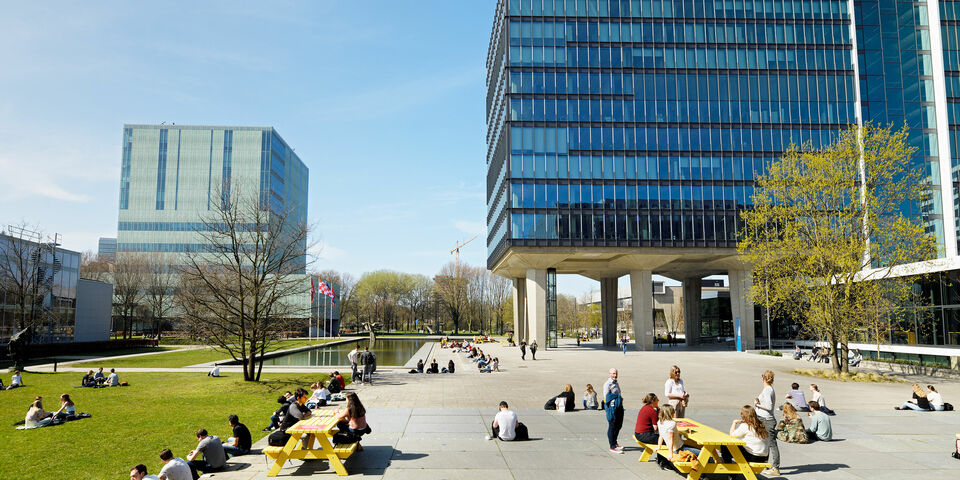Making the campus more accessible to everyone
On October 4, TU/e will host an event themed around physical accessibility. Policymakers from universities and universities of applied sciences, students with and without a disability and other interested parties will join forces to share their knowledge and experiences and explore what’s already going right and what can be improved. By taking stock of the problems and looking for solutions together, the campus can be made more accessible to everyone.
The Physical Accessibility in Higher Education Network, whose members include several universities – including TU/e – and universities of applied sciences, regularly organizes knowledge-sharing events. The next one will take place on Wednesday, October 4, and will be hosted by TU/e. “The goal of these gatherings is to share and acquire knowledge, exchange experiences and explore what’s going right and what can be improved,” says Nikki Westervoort, one of the event organizers on behalf of Real Estate. “Identifying bottlenecks and sharing good practices is extremely important, because many institutions are facing the same problems.”
Campus tour
“The morning program is geared towards knowledge sharing, with lectures by different parties,” Westervoort tells us. “In the afternoon we’ll get hands-on with a tour of the campus and the Flux building.” This is organized by Built Environment master’s students that are starting a graduation project in the area of physical accessibility this year. “This group of soon-to-be graduates will be designing homes for people with a disability, in particular senior citizens,” she explains. “We want to see if we can link these master’s students to students with a disability, as its important to look at the surroundings from the perspective of the latter group.”
“For example, we once took a walk on campus with Tom Sanders, a student of physics at Fontys who has a visual impairment. He flagged things he noticed that we weren’t aware of,” she continues. “Take the walking route from the Atlas building to Flux. Most people pass through the Markthal at MetaForum, but Tom commented that this is very uncomfortable if you don’t see well, because of the large staircases, constant mix of darkness and light and the lack of an uninterrupted sight line to see where you’re going. So he prefers walking on the other side, which I myself would be hesitant to do because of the large number of cyclists whooshing by there,” says Westervoort. “Thanks to these kinds of practical experiences, you start looking at your surroundings differently and noticing other things,” she concludes.
Grey
In her opinion, one of the points of improvement on the TU/e campus is its hugely monochromous nature. “Everything is so grey here, providing very little contrast. This is at the expense of the visibility of the stairs, for instance,” she asserts. “You’d really want yellow stripes on the steps, so it’s easy to see where the staircase starts, but that doesn’t look that nice. So we’re constantly looking for the right balance between practical and aesthetically pleasing.”
Westervoort is on the integral accessibility working group, which brings together different stakeholders, including Real Estate, Occupational Health and HR. “In this working group, we get input from students and staff about the accessibility of our buildings and rooms and then we get to work on that. In so doing, we try to make sure no one is forgotten. For instance, a lot of attention goes out to students with a disability, but what if the teacher’s in a wheelchair? These are the kinds of questions we concern ourselves with.”
“The other day we changed the handrail of a long staircase,” she goes on. “There’s a fire hose reel on the wall there and if you were holding the handrail, you’d almost run into it. The rail was given an extra curve to solve this problem.” This goes to show that many of the obstacles can be removed by making relatively small changes.
Low-stimulus rooms
She stresses that physical accessibility isn’t only about the needs of students and staff with a physical impairment. When designing physical spaces, you also have to take into account those with autism or stimulus processing problems. But in her experience, less visible functional impairments often get snowed under a bit. “When you talk about physical accessibility, a lot of people automatically think of wheelchair accessibility, but psychological needs are equally important and are fortunately getting more and more attention. For instance, we are now looking into creating low-stimulus rooms for people to withdraw to if necessary.”
Briefly returning to the subject of wheelchair accessibility, Westervoort thinks the TU/e campus is generally wheelchair-friendly and that all of the buildings are well-accessible. What could be improved, she thinks, is the provision of information: wheelchair entrances aren’t always easy to find. “If you’re in a wheelchair, you often have to figure out the entire route in advance, as well as which entrance you can use, things you probably won’t give any thought if you don’t have any mobility problems. That’s why it’s important for all information to be properly available and easy to find. So that’s also something we’re working on.”
Creating awareness
The event on physical accessibility on October 4 isn’t only targeted at people with a disability and at policymakers; everyone who’s interested in the topic can join. Even though it might be more interesting to Built Environment students than to Mathematics students, Westervoort believes it would benefit anyone and everyone. “Listening to experiences of people with a disability and looking at the surroundings from their perspective creates greater awareness. It makes you more compassionate towards others.”
If you’re interested in the event, you can register by sending an email to Nikki Westervoort or Bert Verheijen. Attendance is free and there is room for up to fifty participants.



Discussion